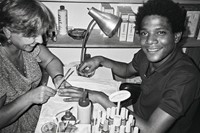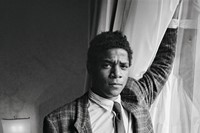A new book looks at the five-year friendship and working relationship between the two seminal artists, via diary entries and photographs by Andy Warhol
For five years during the 1980s, Andy Warhol and Jean Michel Basquiat were close friends and collaborators. The two artists met in 1982, when they were at different stages of their respective careers: Basquiat was an emerging but talked-about graffiti artist, known for using the tag SAMO; while Warhol had already experienced success, in the 60s, and was in this decade experiencing a period of renewed creativity. Now in his fifties, Warhol’s habit of collecting and documenting his life was second nature – be it through photography, keeping newspaper clippings and other ephemera, sketching, or dictating his days to Pat Hackett for what would eventually become The Andy Warhol Diaries. Extracts of these diaries feature in Warhol on Basquiat, a new Taschen-published tome that explores the unique relationship these two artists fostered, illustrated with Warhol’s photographs of himself, Basquiat and a cast of recurring characters like Madonna, Isabella Blow, Andre Leon Talley, Keith Haring, Anna Wintour, Bryan Ferry, Yoko Ono, and Grace Jones.
With Basquiat at the beginning of his career and Warhol well into his (though they would both die unexpectedly in 1987, Warhol in February at the age of 58, and Basquiat in August at 27), the pair met in the middle and began painting together. Warhol’s photographs offer a glimpse into this working relationship, which produced canvases combining each of their stylistic tropes. Accompanying the images, Warhol’s wry diary entries reveal the intricacies of the pairing – the two artists were somewhat competitive as they existed simultaneously in the New York art world. “Tried Jean Michel because he’d wanted to go to the Pop Art show at the Whitney and then work together, but he wasn’t around. Jon and I went there without him. There’s some early stuff of mine, a lot of mine. Jean Michel had told me he thought my stuff looked the best, but you know,” reads an extract from September 1984. “So then wandered the streets, went home and Jean Michel called. Now he has rooms in two hotels. One at the Ritz Carlton and then he moved to the Mayfair Regent on 65th Street. I guess he was competing with me to live in the chic East 60s. I told him that the TV was terrible around here and he didn’t believe me, but when he got to the Mayfair and found out he couldn’t get the Showtime channel or anything like that he learned his lesson. Good TV means a lot. So he went back to the Ritz Carlton. He has a big Jacuzzi there.”

Warhol on Basquiat reveals the intimacy that the two artists’ friendship was rooted in. Warhol documented highs and lows, describing periods of intense productivity and alternately moments of frustration at the younger artist (he “slapped him in the face” in October 1983, “kind of hard”), and also the banalities of their friendship. The pair would work out together in Warhol’s studio, buy clothes, eat Chinese food, discuss rent and gallery representation, and even get manicures. “Jean Michel and I went over to Yanna’s, and we had our nails done. And you know, my nails are getting better. The two of us would make a good story for Vogue,” said Warhol.
With this insight into one of the art world’s most famous friendships also comes a look at the meteoric rise of Basquiat in 1980s New York. From a 22-year-old worried he’ll be “a flash in the pan” to an artist whose paintings sold for tens of thousands of dollars, Warhol reveals another side to Basquiat. The younger artist would reference his tumultuous childhood, which saw him attending a New York private school at one point and a homeless teenager at another, and he would invite Warhol to meet his younger sisters and his parents. With Basquiat’s artistic success came wealth and paranoia, both impacted by his drug use, of which Warhol was very aware. Many accounts exist of Basquiat’s shyness, but through Warhol’s lens he is seen experiencing his growing success with ease.
Warhol on Basquiat: The Iconic Relationship Told in Andy Warhol’s Words and Pictures, edited by Michael Dayton Hermann, is published by Taschen on June 3, 2019.






